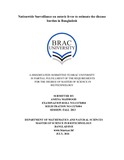Nationwide surveillance on enteric fever to estimate the disease burden in Bangladesh
Abstract
Enteric fever is a life threatening febrile illness caused by Salmonella Typhi and Paratyphi found highly prevalent in developing countries like Bangladesh. The government and non-government organization is working together for minimizing the burden of disease through active surveillance, ongoing collection of data, analysis and interpretation of data. The aim of the current study was to estimate the prevalence in different sentinel sites using data of laboratory confirming diagnosis, identification of high risk population, risk factors for acquiring the disease, and antimicrobial susceptibility of S. Typhi and S. Paratyphi A. During the study period May, 2014 to December, 2015 specimens were collected from ten different hospital facilities divided into seven divisions. The TPTest and blood culture methods were used for understanding the disease burden as well as serotyping of enteric fever. Total 2036 and 2068 specimens were tested by TPTest and blood culture respectively. A total of 530 (26.03%) specimens were positive by the TPTest; whereas 59 (2.85%) cases were positive by blood culture. Among blood culture positive specimens 46 (78%) cases were S. Typhi and 13 (22%) were S. Paratyphi A. The highest number of enteric fever positive cases was found in Dhaka (TPTest 57.17%; blood culture 59.32%) division followed by Barisal and Chittagong. During the two years of surveillance two peak seasons have been observed. The first peak was observed in month of August and second peak was November-December of 2014 and 2015. Enteric fever was more prevalent among adults aged ≥18 years (278 was positive by TPTest, 16 was positive by blood culture); whereas younger children aged 6-17 years (176 was positive by TPTest, 22 was positive by culture) were also found susceptible. Males (36 cases was culture positive) were more positive than females (10 cases was culture positive). A higher number of the febrile patients had taken antibiotics (33.6%) before enrolment rationalized the lower incidence rate of blood culture. Among the isolated S. Typhi and S. Paratyphi A strains, 100% had shown reduced susceptibility to ciprofloxacin. This study demonstrates that enteric fever is highly prevalent in Bangladesh. The findings of the study also imparts the importance of proper vaccination program with an effective and immunogenic vaccine.

